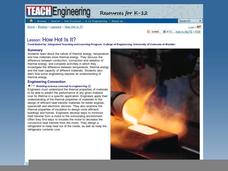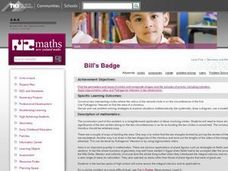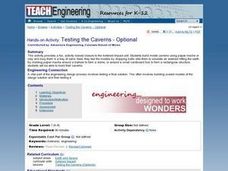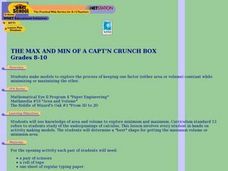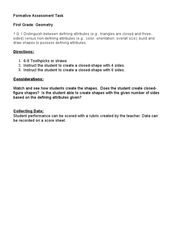Teach Engineering
Copycat Engineers
It's often said that imitation is the sincerest form of flattery. Young engineers learn about biomimicry, which uses nature to generate engineering ideas, in the fifth lesson of nine in a Life Science unit. Working in groups, they select...
Teach Engineering
Global Climate Change
The greenhouse effect and its relationship to global warming is the focus of an activity that asks class member to consider the effects of climate change on weather. Pupils work with their families to determine their carbon footprints...
Teach Engineering
How Hot is Hot?
Elementary schoolers identify the three methods of heat transfer: conduction, convection, and radiation. The instructional activity is mostly lecture-based. When the teacher has finished the presentation, groups of pupils get into teams...
Teach Engineering
Solar Power
How much solar energy is available at my location? An engaging resource provides a presentation along with script to give the class background information on determining solar radiation. Pupils then work through a worksheet to estimate...
Teach Engineering
It's Tiggerific!
Spring into elastic potential energy with a activity that provides background information on determining the elastic potential energy of springs and other elastic materials. General energy equations emphasize the conservation of energy...
Teach Engineering
Extinction Prevention via Engineering
It's time to save endangered species through engineering. The third instructional activity in a nine-part Life Science unit has young environmentalists study species extinction. An engaging discussion leads to some ideas on how to use...
Teach Engineering
Exploring Energy: Kinetic and Potential
The potential of the energy in the class is moving. The third segment in a six-part unit on energy provides a deeper understanding of kinetic and potential energy. Learners understand the relationship between mass, speed, and energy and...
Mascil Project
Parachute Food Drop
Drop a perfect project into your lesson plans. Groups use different building materials to create models of parachutes for food drops. After testing out their prototypes, they make improvements to their designs.
Teach Engineering
Electromagnetic Radiation
How can nanoparticles be used in the battle against skin cancer. Class members take on the question as they gather information about electromagnetic radiation, specifically ultraviolet radiation. Pupils learn about the mathematical...
Curated OER
Does Contact Area Matter?
Students work together to design and implement an experiment on friction. They test to see if contact area affects the amount of friction. They discover how engineers use friction to make certain products better.
Curated OER
Bill's Badge
Students explore the making of circles and concepts related to them in geometry. The project is inquiry based will focus upon students making their own nametags. The construction is ideal for hands on students.
Curated OER
TE Activity: Built to Last?
Fifth graders test the shelters that were built in a prior activity. They determine the level of durability and water resistance of these shelters through a scientific investigation.
Curated OER
TE Activity: Testing the Caverns
Learners make model caverns out of paper mache or clay. They bury them in a tray of sand, and test the models by dropping balls into them simulating as asteroid hitting the earth. They discuss the results of the activity in a whole class...
Curated OER
Million Dollar Gift
Third graders create a box big enough to hold a million dollars. This is a project fun to do near the winter holidays with inexpensive gifts included in the boxes. This hands-on lesson very effectively demonstrates the concept of volume.
Curated OER
Let it Grow, Let it Grow, Let it Grow
Students investigate, through a hands-on activity, in which type of soil a bean seed grows best. They create a bar graph representing each plant's growth in different soils.
Curated OER
TE Lesson: Land on the Run
Students study the causes of different types and speeds of landslides. They determine that landslides are the result of gravity, friction, and the materials involved. They examine the step engineers are taking to prevent and avoid...
Curated OER
Acid (and Base) Rainbows
Learners are introduced to the differences between acids and bases and how to use indicators, such as pH paper and red cabbage juice, to distinguish between them. They make predictions that can be answered through scientific...
Teach Engineering
Weather Basics
Weather — there's more to it than meets the eye of the storm. With this resource young meteorologists learn about the basics of weather, including information about the factors that influence the weather, common weather vocabulary, and...
Curated OER
the Max And Min of a Capt'n Crunch Box
Students use knowledge of area and volume to explore minimum and maximum. They create models and determine a "best" shape for getting the maximum volume or minimum area.
Curated OER
Geometry
Students are introduced to the basics of Geometry. Using cutout shapes, they identify whether they are polygons by using the properties of polygons. They practice drawing shapes they are going to be using on an everyday basis and...
Curated OER
Grid it, Map it
Students participate in designing a city layout using grids and coordinates. They work on a city space and create a grid on a life size layout on the gym floor.
Curated OER
Nature's Polyhedrons
Students are introduced to polyhedrons through using straw models to explore geometric solids and constructing Christmas tree ornaments using Epsom salt crystals. Students will view interactive videos and investigate and retrieve...
Curated OER
Macbeth Madness
Students research Macbeth online and complete computer and graphing activities for the play. In this Macbeth activities lesson, students research Macbeth and bookmark the URL's. Students complete activities for the topic on spreadsheets...
Curated OER
Give It a Whirl
Students examine and identify polyhedron shapes on a math website. They write journal reflections about two- and three-dimensional shapes, and transform a square into a pinwheel.




